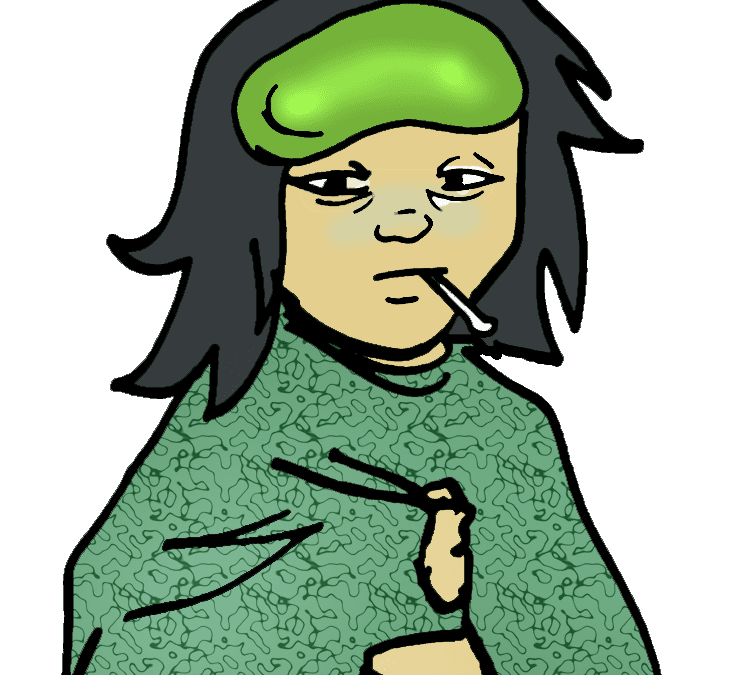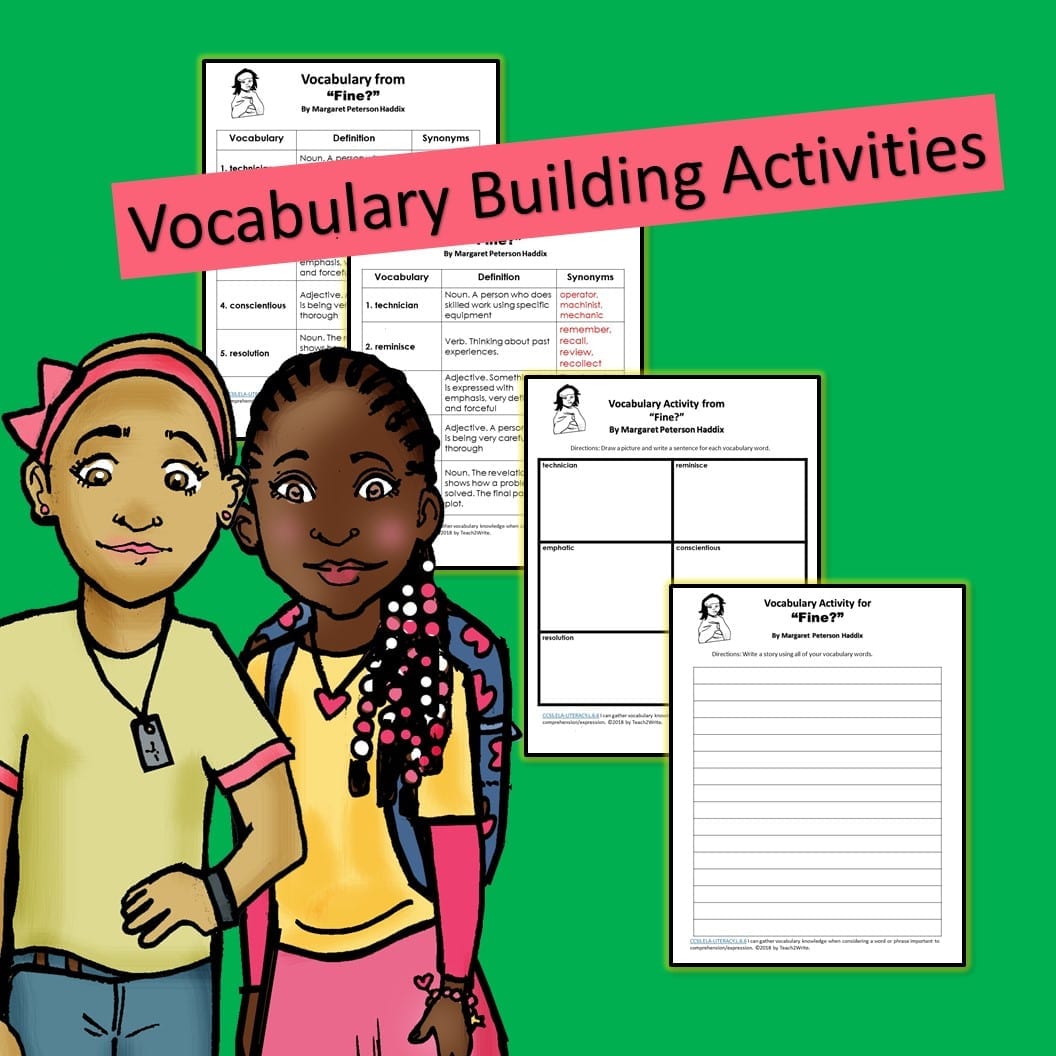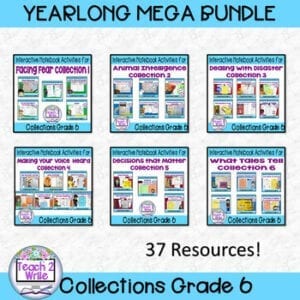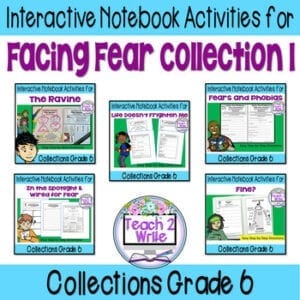The common core standards I focus on for these writing activities are:
CCSS.ELA-LITERACY.RL.6.3 Describe how a particular story or drama’s plot unfolds in a series of episodes as well as how the characters respond or change as the plot moves toward a resolution.
CCSS.ELA-LITERACY.RL.6.6 Explain how an author develops the point of view of the narrator or speaker in a text.
[/et_pb_text]
Vocabulary with Writing Activities Fine Grade 6 HMH :
For new vocabulary of any text, I like to introduce the new words on the projector, one at a time. I teach a word, its pronunciation, parts of speech, definition and synonyms, using the whole brain teaching approach. After this, students rehearse each word with a partner before I teach the next word.
Once I’ve introduced all of the words, I have students work independently, or in pairs, to draw and write sentences to further review these new vocabulary words throughout the week.
To see more ideas about how to play with vocabulary words, read this blog post 5 Word Games to Play with Middle Schoolers .
For ten editable vocabulary and writing activities, students can use with interactive notebooks or in learning centers, click here.
Think about and Writing Activity for the Topic of Being Sick:
With a longer story like Fine? in the HMH Collections Grade 6 text, I want to engage students through appealing to their sense of empathy. Therefore, I encouraged students to write an entry in their interactive notebooks about a time when they were sick, or maybe even had to go to the hospital.
I specifically asked students this question: “How did it feel to be sick, not knowing what was wrong with you?”
After encouraging students to explain these feelings in their notebooks, I shared my own written entry about a time when I was sick in the hospital as a kid and didn’t know what was happening to me. Once I started telling my story, students wanted to share out their stories as well.
As a teacher of writing, I find it valuable and important to get students to write and share their writings. I include writing activities before reading, like freewriting, in every lesson plan that is based on a reading selection.
Writing activities build classroom community, writing skills, self-confidence, and, most importantly, engages students in the reading lesson.
You really want your students to identify with Bailey, the main character in the short story, “Fine.” So, students will want to read to find out what happens to her.
Like I said, Fine, is a long story, so it’s important to get kids invested in what might happen to her so they will want to stick with it.
Previewing Fine 6th-grade story:
Next, I ask my students how they should preview the Fine Grade 6 HMH story, Students turn and talk to a neighbor, while I circulate the room and listen to their discussions. During this preview, I guide them to make predictions based on the title, pictures, pull quotes, and the author’s information.
After about 2-3 minutes, I call the class back to whole group instruction. I randomly call on students to share what their partners thought would happen during the story, “Fine?” and whether or not they agreed with their partner. This makes students listen to each other’s ideas.
The common core standards I focus on for these writing activities are:
CCSS.ELA-LITERACY.RL.6.3 Describe how a particular story or drama’s plot unfolds in a series of episodes as well as how the characters respond or change as the plot moves toward a resolution.
CCSS.ELA-LITERACY.RL.6.6 Explain how an author develops the point of view of the narrator or speaker in a text.
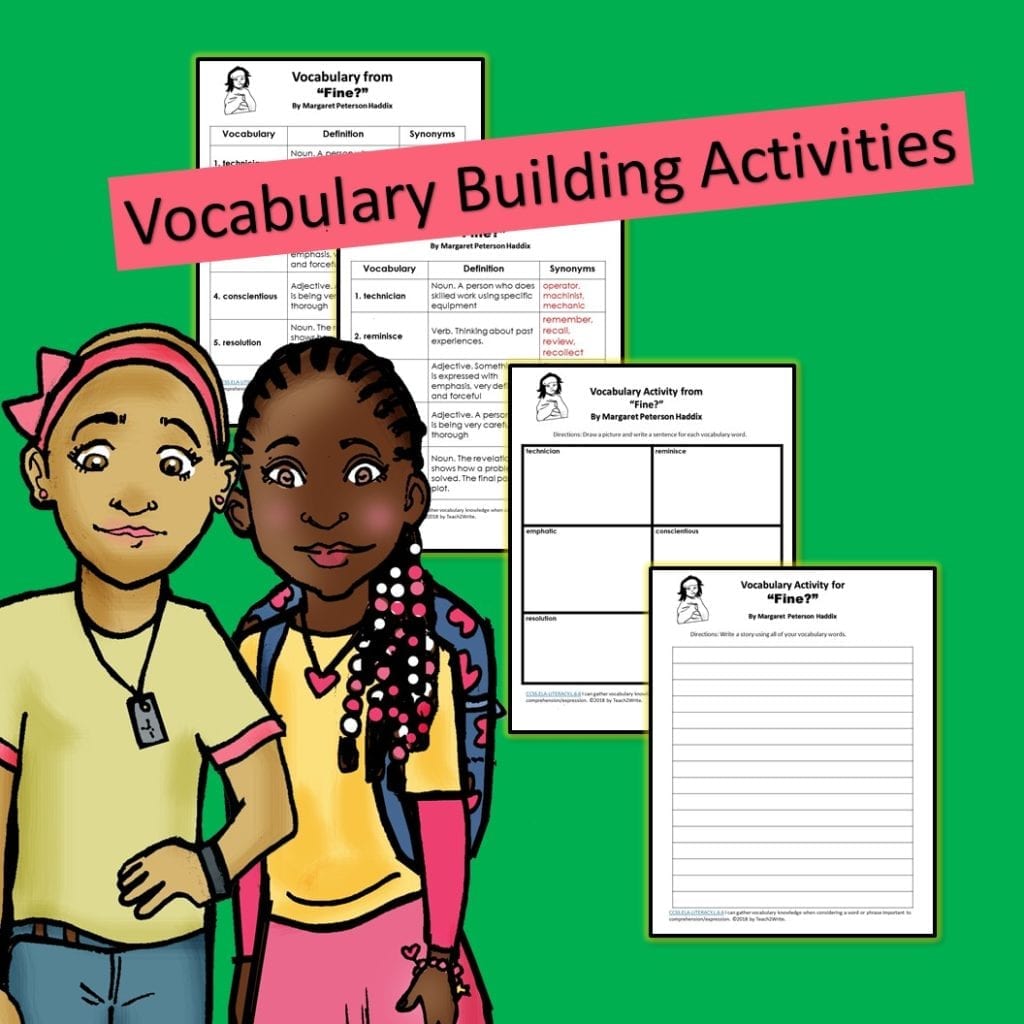
Vocabulary with Writing Activities Fine Grade 6 HMH :
For new vocabulary of any text, I like to introduce the new words on the projector, one at a time. I teach a word, its pronunciation, parts of speech, definition and synonyms, using the whole brain teaching approach. After this, students rehearse each word with a partner before I teach the next word.
Once I’ve introduced all of the words, I have students work independently, or in pairs, to draw and write sentences to further review these new vocabulary words throughout the week.
To see more ideas about how to play with vocabulary words, read this blog post 5 Word Games to Play with Middle Schoolers .
For ten editable vocabulary and writing activities students can use with interactive notebooks or in learning centers, click here.
Think about and Writing Activity for the Topic of being Sick:
With a longer story like Fine? in the HMH Collections Grade 6 text, I want to engage students through appealing to their sense of empathy. Therefore, I encouraged students to write an entry in their interactive notebooks about a time when they were sick, or maybe even had to go to the hospital.
I specifically asked students this question: “How did it feel to be sick, not knowing what was wrong with you?”
After encouraging students to explain these feelings in their notebooks, I shared my own written entry about a time when I was sick in the hospital as a kid and didn’t know what was happening to me. Once I started telling my story, students wanted to share out their stories as well.
As a teacher of writing, I find it valuable and important to get students to write and share their writings. I include writing activities before reading, like freewriting, in every lesson plan that is based on a reading selection.
Writing activities build classroom community, writing skills, self-confidence and, most importantly, engages students in the reading lesson.
You really want your students to identify with Bailey, the main character in the short story, “Fine.” So, students will want to read to find out what happens to her.
Like I said, Fine, is a long story, so it’s important to get kids invested in what might happen to her so they will want to stick with it.
Previewing Fine 6th grade story:
Next, I ask my students how they should preview the Fine Grade 6 HMH story, Students turn and talk to a neighbor, while I circulate the room and listen to their discussions. During this preview I guide them to make predictions based on the title, pictures, pull quotes and the author information.
After about 2-3 minutes, I call the class back to whole group instruction. I randomly call on students to share what their partners thought would happen during the story, “Fine?” and whether or not they agreed with their partner. This makes students listen to each other’s ideas.
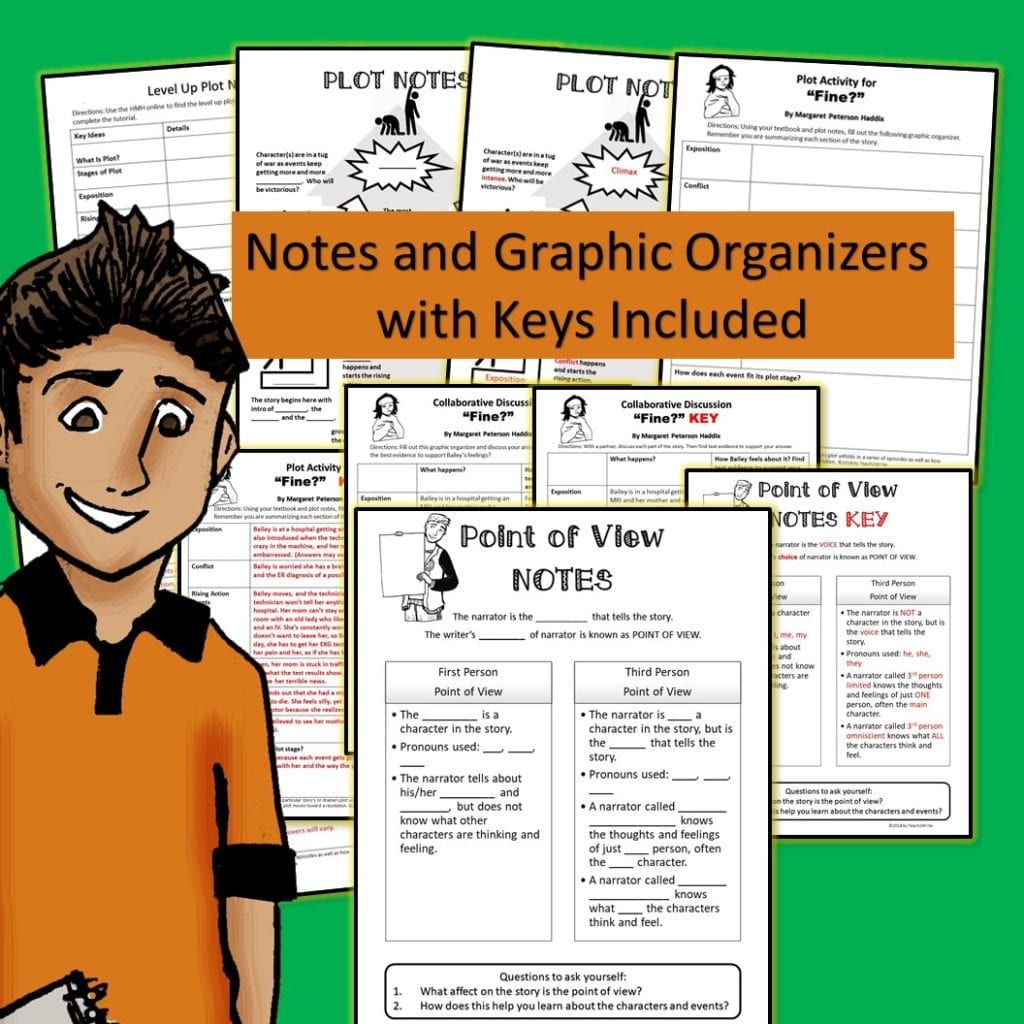
Reading and Writing Activities Fine Grade 6 HMH:
There are multiple ways to read Fine? from HMH Collections Grade 6. However, due to its length and the attention span of sixth graders, I had students read this text with a partner (unless they preferred to read alone).
I also pulled a small group of students, who often struggle with reading long texts, such as my SPED or ESL students, and I worked with them.
With one of my classes, I decided to listen to the recording of “Fine?” in the HMH Collections Grade 6 online textbook. At the end of each page, I asked these comprehension questions:
- Why is Bailey afraid of the machine?
- Why does she think something awful is going to happen?
- Who supports her during this conflict?
- Why is she embarrassed by her mom?
Another time I taught this text, I read the first page aloud with students, and then had students read independently. To help students with reading comprehension, I directed students to summarize each page of the story in their interactive notebooks. This writing activity for Fine, Grade 6, firmly establishes the plot of the story in their heads.
After Reading Activities for the Fine 6th grade story:
After we read the “Fine?” students complete the Level Up activities about Plot and Point of View. These interactive activities in the HMH Collections online textbook are both informative and provide excellent review.
Students could work on these Level Up activities in stations or centers or on their own electronic devices.
Next, I had students complete these writing activities in their interactive notebooks:
- record important plot points on a plot chart graphic organizer
- collaborative discussion at the end of the story (one of the HMH Collections Grade 6 Activities in every selection)
- identify Bailey’s internal and external conflicts, which helps students understand Bailey’s point of view as well.
Writing Activities Fine Grade 6 after Reading:
After reading, I also have students work on writing activities for Fine Grade 6. To practice writing skills, my students add to their entries in their notebooks about a time when they were sick (see above).
Students add more details about their experiences of what the doctor’s office was like, their symptoms, what they thought was wrong with them, fears or anxieties they had about being sick and how their family members reacted. Having students reexamine these ideas, also builds empathy as well as gets them to think about how authors add details to their narratives.
I have my students read their entries aloud to a partner to find their editing mistakes, which they correct in a different color ( a pen or a colored pencil).
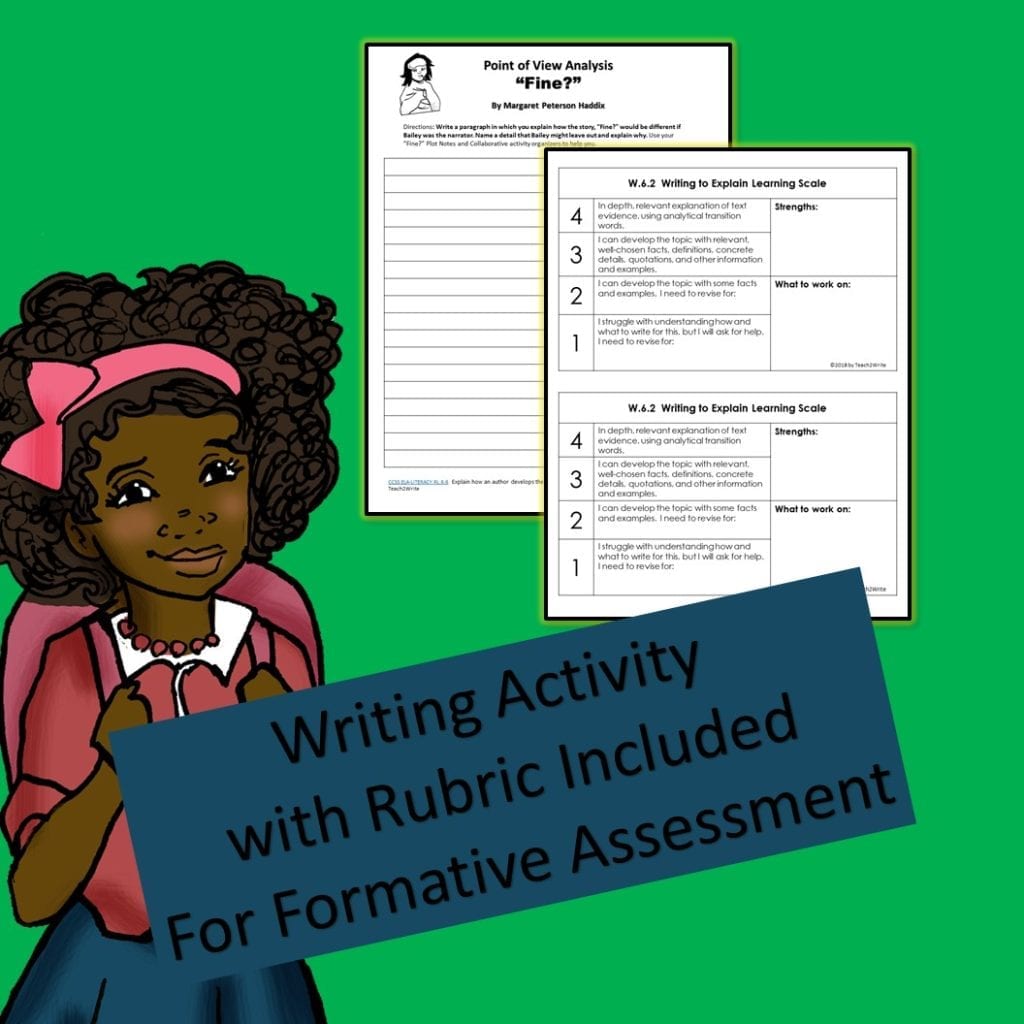
Students later choose which writing activities they would like to write as a final draft to turn in to me for a writing grade later in the quarter.
My students also complete the writing activity for Fine grade 6 for the performance task in the HMH Collections textbook.
This writing activity prompts students to write some of the story from Bailey’s mom’s point of view. We follow this with a discussion about how the story’s focus changes from Bailey’s worries to her mother’s anxieties.
Other Writing Resources Fine Grade 6:
If you would like the graphic organizers I use for how I teach “Fine?” HMH Collection, Grade 6, click this link to get those materials in my TPT store: HMH Collections Grade 6 Collection 1 Fine? Activities
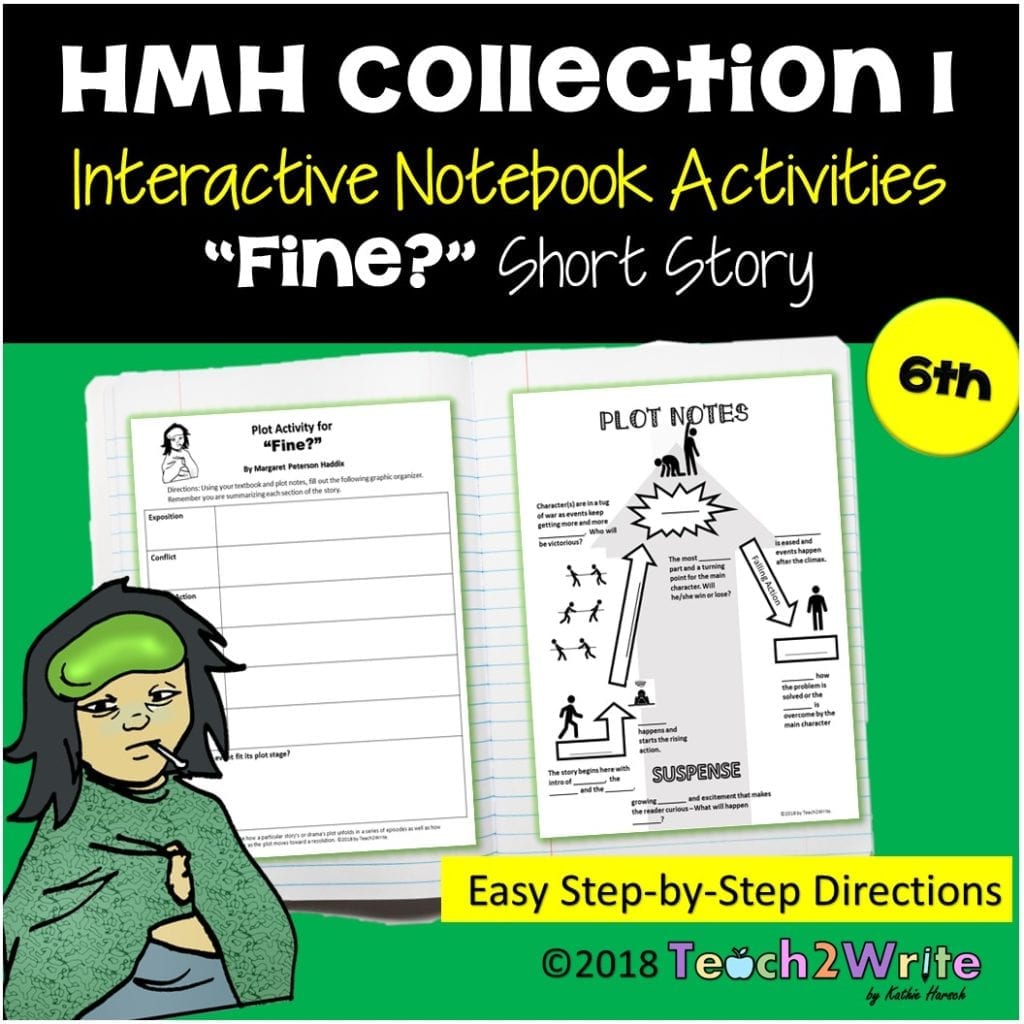
For other writing activities ideas, for the HMH Collections Grade 6, see this blog post: Black Ships Before Troy
You can find a Bundle of Collection 1 HMH Resources for Interactive Notebook and the year-long bundle fromFlorida texts here:
[/et_pb_text][/et_pb_column][/et_pb_row][/et_pb_section]
Writing Activities Fine Grade 6 HMH – this post is designed to help busy English Language Arts teachers with the short story “Fine?” in the HMH Collections Grade 6, Collection 1.
The short story from HMH Collections Grade 6 “Fine?” is rather long and may need some scaffolding for your kiddos. I’ve created many lesson plans and writing resources for this textbook. Here are the writing resources I use for the story, Fine?
Common Core Standards taught in Fine Grade 6 HMH
The common core standards I focus on for these writing activities are:
CCSS.ELA-LITERACY.RL.6.3 Describe how a particular story or drama’s plot unfolds in a series of episodes as well as how the characters respond or change as the plot moves toward a resolution.
CCSS.ELA-LITERACY.RL.6.6 Explain how an author develops the point of view of the narrator or speaker in a text.
Vocabulary with Writing Activities Fine Grade 6 HMH :
For new vocabulary of any text, I like to introduce the new words on the projector, one at a time. I teach a word, its pronunciation, parts of speech, definition and synonyms, using the whole brain teaching approach. After this, students rehearse each word with a partner before I teach the next word.
Once I’ve introduced all of the words, I have students work independently, or in pairs, to draw and write sentences to further review these new vocabulary words throughout the week.
To see more ideas about how to play with vocabulary words, read this blog post 5 Word Games to Play with Middle Schoolers .
For ten editable vocabulary and writing activities, students can use with interactive notebooks or in learning centers, click here.
Think about and Writing Activity for the Topic of Being Sick:
With a longer story like Fine? in the HMH Collections Grade 6 text, I want to engage students through appealing to their sense of empathy. Therefore, I encouraged students to write an entry in their interactive notebooks about a time when they were sick, or maybe even had to go to the hospital.
I specifically asked students this question: “How did it feel to be sick, not knowing what was wrong with you?”
After encouraging students to explain these feelings in their notebooks, I shared my own written entry about a time when I was sick in the hospital as a kid and didn’t know what was happening to me. Once I started telling my story, students wanted to share out their stories as well.
As a teacher of writing, I find it valuable and important to get students to write and share their writings. I include writing activities before reading, like freewriting, in every lesson plan that is based on a reading selection.
Writing activities build classroom community, writing skills, self-confidence, and, most importantly, engages students in the reading lesson.
You really want your students to identify with Bailey, the main character in the short story, “Fine.” So, students will want to read to find out what happens to her.
Like I said, Fine, is a long story, so it’s important to get kids invested in what might happen to her so they will want to stick with it.
Previewing Fine 6th-grade story:
Next, I ask my students how they should preview the Fine Grade 6 HMH story, Students turn and talk to a neighbor, while I circulate the room and listen to their discussions. During this preview, I guide them to make predictions based on the title, pictures, pull quotes, and the author’s information.
After about 2-3 minutes, I call the class back to whole group instruction. I randomly call on students to share what their partners thought would happen during the story, “Fine?” and whether or not they agreed with their partner. This makes students listen to each other’s ideas.
“Fine” Writing Activities for grade 6 – this post is designed to help busy English Language Arts teachers with the short story “Fine?” in the HMH Collections Grade 6, Collection 1.
The short story from HMH Collections Grade 6 “Fine?” is rather long and may need some scaffolding for your kiddos. I’ve created many lesson plans and writing resources for this textbook. Here are the writing resources I use for the story, Fine?
Common Core Standards taught in Fine Grade 6 HMH
The common core standards I focus on for these writing activities are:
CCSS.ELA-LITERACY.RL.6.3 Describe how a particular story or drama’s plot unfolds in a series of episodes as well as how the characters respond or change as the plot moves toward a resolution.
CCSS.ELA-LITERACY.RL.6.6 Explain how an author develops the point of view of the narrator or speaker in a text.

Vocabulary with Writing Activities Fine Grade 6 HMH :
For new vocabulary of any text, I like to introduce the new words on the projector, one at a time. I teach a word, its pronunciation, parts of speech, definition and synonyms, using the whole brain teaching approach. After this, students rehearse each word with a partner before I teach the next word.
Once I’ve introduced all of the words, I have students work independently, or in pairs, to draw and write sentences to further review these new vocabulary words throughout the week.
To see more ideas about how to play with vocabulary words, read this blog post 5 Word Games to Play with Middle Schoolers .
For ten editable vocabulary and writing activities students can use with interactive notebooks or in learning centers, click here.
Think about and Writing Activity for the Topic of being Sick:
With a longer story like Fine? in the HMH Collections Grade 6 text, I want to engage students through appealing to their sense of empathy. Therefore, I encouraged students to write an entry in their interactive notebooks about a time when they were sick, or maybe even had to go to the hospital.
I specifically asked students this question: “How did it feel to be sick, not knowing what was wrong with you?”
After encouraging students to explain these feelings in their notebooks, I shared my own written entry about a time when I was sick in the hospital as a kid and didn’t know what was happening to me. Once I started telling my story, students wanted to share out their stories as well.
As a teacher of writing, I find it valuable and important to get students to write and share their writings. I include writing activities before reading, like freewriting, in every lesson plan that is based on a reading selection.
Writing activities build classroom community, writing skills, self-confidence and, most importantly, engages students in the reading lesson.
You really want your students to identify with Bailey, the main character in the short story, “Fine.” So, students will want to read to find out what happens to her.
Like I said, Fine, is a long story, so it’s important to get kids invested in what might happen to her so they will want to stick with it.
Previewing Fine 6th grade story:
Next, I ask my students how they should preview the Fine Grade 6 HMH story, Students turn and talk to a neighbor, while I circulate the room and listen to their discussions. During this preview I guide them to make predictions based on the title, pictures, pull quotes and the author information.
After about 2-3 minutes, I call the class back to whole group instruction. I randomly call on students to share what their partners thought would happen during the story, “Fine?” and whether or not they agreed with their partner. This makes students listen to each other’s ideas.

Reading and Writing Activities Fine Grade 6 HMH:
There are multiple ways to read Fine? from HMH Collections Grade 6. However, due to its length and the attention span of sixth graders, I had students read this text with a partner (unless they preferred to read alone).
I also pulled a small group of students, who often struggle with reading long texts, such as my SPED or ESL students, and I worked with them.
With one of my classes, I decided to listen to the recording of “Fine?” in the HMH Collections Grade 6 online textbook. At the end of each page, I asked these comprehension questions:
- Why is Bailey afraid of the machine?
- Why does she think something awful is going to happen?
- Who supports her during this conflict?
- Why is she embarrassed by her mom?
Another time I taught this text, I read the first page aloud with students, and then had students read independently. To help students with reading comprehension, I directed students to summarize each page of the story in their interactive notebooks. This writing activity for Fine, Grade 6, firmly establishes the plot of the story in their heads.
After Reading Activities for the Fine 6th grade story:
After we read the “Fine?” students complete the Level Up activities about Plot and Point of View. These interactive activities in the HMH Collections online textbook are both informative and provide excellent review.
Students could work on these Level Up activities in stations or centers or on their own electronic devices.
Next, I had students complete these writing activities in their interactive notebooks:
- record important plot points on a plot chart graphic organizer
- collaborative discussion at the end of the story (one of the HMH Collections Grade 6 Activities in every selection)
- identify Bailey’s internal and external conflicts, which helps students understand Bailey’s point of view as well.
Writing Activities Fine Grade 6 after Reading:
After reading, I also have students work on writing activities for Fine Grade 6. To practice writing skills, my students add to their entries in their notebooks about a time when they were sick (see above).
Students add more details about their experiences of what the doctor’s office was like, their symptoms, what they thought was wrong with them, fears or anxieties they had about being sick and how their family members reacted. Having students reexamine these ideas, also builds empathy as well as gets them to think about how authors add details to their narratives.
I have my students read their entries aloud to a partner to find their editing mistakes, which they correct in a different color ( a pen or a colored pencil).

Students later choose which writing activities they would like to write as a final draft to turn in to me for a writing grade later in the quarter.
My students also complete the writing activity for Fine grade 6 for the performance task in the HMH Collections textbook.
This writing activity prompts students to write some of the story from Bailey’s mom’s point of view. We follow this with a discussion about how the story’s focus changes from Bailey’s worries to her mother’s anxieties.
Other Writing Resources Fine Grade 6:
If you would like the graphic organizers I use for how I teach “Fine?” HMH Collection, Grade 6, click this link to get those materials in my TPT store: HMH Collections Grade 6 Collection 1 Fine? Activities

For other writing activities ideas, for the HMH Collections Grade 6, see this blog post: Black Ships Before Troy
You can find a Bundle of Collection 1 HMH Resources for Interactive Notebook and the year-long bundle fromFlorida texts here:
Writing Activities Fine Grade 6 HMH – this post is designed to help busy English Language Arts teachers with the short story “Fine?” in the HMH Collections Grade 6, Collection 1.
The short story from HMH Collections Grade 6 “Fine?” is rather long and may need some scaffolding for your kiddos. I’ve created many lesson plans and writing resources for this textbook. Here are the writing resources I use for the story, Fine?
Common Core Standards taught in Fine Grade 6 HMH
The common core standards I focus on for these writing activities are:
CCSS.ELA-LITERACY.RL.6.3 Describe how a particular story or drama’s plot unfolds in a series of episodes as well as how the characters respond or change as the plot moves toward a resolution.
CCSS.ELA-LITERACY.RL.6.6 Explain how an author develops the point of view of the narrator or speaker in a text.
Vocabulary with Writing Activities Fine Grade 6 HMH :
For new vocabulary of any text, I like to introduce the new words on the projector, one at a time. I teach a word, its pronunciation, parts of speech, definition and synonyms, using the whole brain teaching approach. After this, students rehearse each word with a partner before I teach the next word.
Once I’ve introduced all of the words, I have students work independently, or in pairs, to draw and write sentences to further review these new vocabulary words throughout the week.
To see more ideas about how to play with vocabulary words, read this blog post 5 Word Games to Play with Middle Schoolers .
For ten editable vocabulary and writing activities, students can use with interactive notebooks or in learning centers, click here.
Think about and Writing Activity for the Topic of Being Sick:
With a longer story like Fine? in the HMH Collections Grade 6 text, I want to engage students through appealing to their sense of empathy. Therefore, I encouraged students to write an entry in their interactive notebooks about a time when they were sick, or maybe even had to go to the hospital.
I specifically asked students this question: “How did it feel to be sick, not knowing what was wrong with you?”
After encouraging students to explain these feelings in their notebooks, I shared my own written entry about a time when I was sick in the hospital as a kid and didn’t know what was happening to me. Once I started telling my story, students wanted to share out their stories as well.
As a teacher of writing, I find it valuable and important to get students to write and share their writings. I include writing activities before reading, like freewriting, in every lesson plan that is based on a reading selection.
Writing activities build classroom community, writing skills, self-confidence, and, most importantly, engages students in the reading lesson.
You really want your students to identify with Bailey, the main character in the short story, “Fine.” So, students will want to read to find out what happens to her.
Like I said, Fine, is a long story, so it’s important to get kids invested in what might happen to her so they will want to stick with it.
Previewing Fine 6th-grade story:
Next, I ask my students how they should preview the Fine Grade 6 HMH story, Students turn and talk to a neighbor, while I circulate the room and listen to their discussions. During this preview, I guide them to make predictions based on the title, pictures, pull quotes, and the author’s information.
After about 2-3 minutes, I call the class back to whole group instruction. I randomly call on students to share what their partners thought would happen during the story, “Fine?” and whether or not they agreed with their partner. This makes students listen to each other’s ideas.

